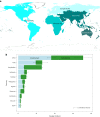Fishing for subsistence constitutes a livelihood safety net for populations dependent on aquatic foods around the world
- PMID: 37749393
- PMCID: PMC10589092
- DOI: 10.1038/s43016-023-00844-4
Fishing for subsistence constitutes a livelihood safety net for populations dependent on aquatic foods around the world
Abstract
Fishing for subsistence constitutes a livelihood safety net for poverty, malnutrition and gender inequality for populations dependent upon aquatic foods around the world. Here we provide global estimates showing that almost the same amount of small-scale fishers engage in subsistence fishing at some point during the year as in commercial employment and use subsistence estimates to measure small-scale fisheries' livelihood safety net function. In 2016, we estimate that 52.8 million people were engaged in subsistence fishing at some point during the year, while another 60.2 million people were commercially employed (90% of global fisheries employment). From 14 country case studies, it was possible to estimate that the subsistence catch provided an average apparent intake of six nutrients critical for positive health outcomes, equivalent to 26% of the recommended daily nutrient intake for 112.5 million people, higher than the national average contribution of beef or poultry.
© 2023. The Author(s).
Conflict of interest statement
The authors declare no competing interests.
Figures





References
-
- Cooley, S. et al. in: Climate Change 2022: Impacts, Adaptation and Vulnerability (eds Pörtner, H.-O. et al.) (Cambridge Univ. Press, 2022).
-
- Smith H, Basurto X. Defining small-scale fisheries and examining the role of science in shaping perceptions of who and what counts: A systematic review. Front. Mar. Sci. 2019;6:236. doi: 10.3389/fmars.2019.00236. - DOI
-
- Béné C, Hersoug B, Allison EH. Not by rent alone: analyzing the pro-poor functions of small-scale fisheries in developing countries. Dev. Policy Rev. 2010;28:325–358. doi: 10.1111/j.1467-7679.2010.00486.x. - DOI
-
- Béné, C. Small-scale Fisheries: Assessing Their Contribution to Rural Livelihoods in Developing Countries. FAO Fisheries Circular No. 1008 (FAO, 2006).
Grants and funding
LinkOut - more resources
Full Text Sources

